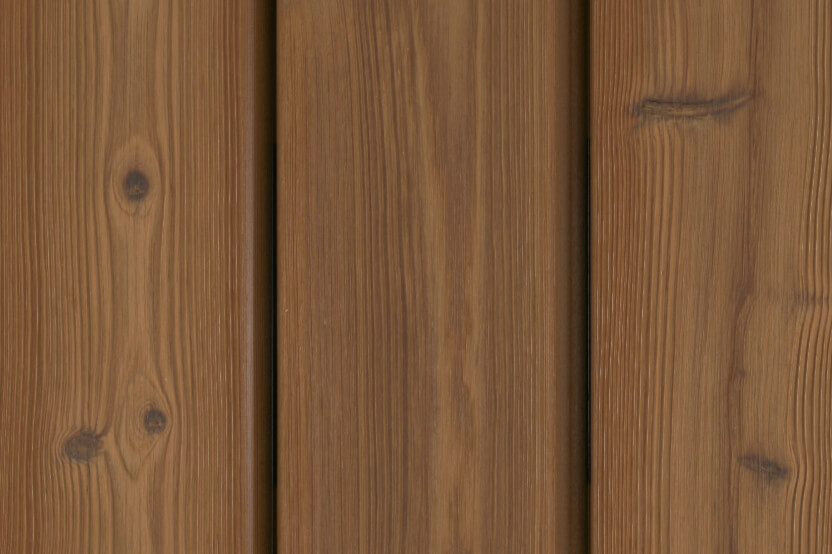What is timber grading and why is it so important?
When it comes to choosing timber for cladding, decking, or any architectural application, appearance isn’t the only factor to consider – performance matters too. That’s where grading comes in. Timber grading ensures that the material not only looks good but performs reliably over time. In this blog, Scott McNeill, our Sales, Technical and R&D Support, explains what timber grading is, why it matters, and how it helps you – whether you’re an architect, contractor, or homeowner – make better-informed choices and avoid surprises down the line.

What is timber grading?
Timber grading is the process of assessing boards to determine their appearance, strength, and suitability for specific applications. At Russwood, it’s a crucial part of delivering products that meet both our own high standards and our customers’ expectations.
Grading terms can vary depending on the purpose – some timbers are graded for structural strength (especially for load-bearing applications), while others, like our cladding and decking boards, are graded for appearance and durability. The grading criteria depend on factors like the species, end use, and whether the timber is modified, coated, or left untreated.
Visual grading vs defect grading
There are different types of timber grading, and each serves a specific purpose:
- Visual Grading involves inspecting boards by eye to assess their appearance and structural features – things like knot size, grain orientation, and any natural imperfections.
- Defect Grading focuses on identifying and excluding features that could compromise performance, such as loose knots, sapwood, cracks, bank encrusted knots, decay and sawing and machining defects.
At Russwood, we carry out in-house visual and defect grading for all our cladding and decking timbers. This hands-on approach gives us greater control over the final product, ensuring consistent quality from board to board.


Why in-house grading sets us apart
Unlike some suppliers who rely on external mills or third-party grading, we carry out all grading in-house at our Newtonmore site. Here’s why that matters:
- Consistency – Our experienced team applies the same grading standards every time, so customers know exactly what to expect.
- Transparency – Every quote from Russwood includes detailed grading information specific to the species and any coatings.
- Quality Control – We can catch and remove boards that don’t meet our standards before they ever reach your site.
This rigorous process ensures you get timber that not only looks great but also lasts – saving time, reducing waste, and giving peace of mind. It also eliminates snagging and wasted time on site.
Examples of Russwood grading in practice
Heartwood of Scottish Larch (Scotlarch®) Specification –
FSC-certified
Sustainably sourced from well-managed forests in Scotland.
Graded to BS1186-3 Part 4 Class 3
Suitable for external cladding, with tight live knots up to 50mm in diameter.
Sapwood-free on the working face
Durable for uncoated use – can leave a clean, natural look without compromising performance.
May include resin pockets
A harmless, natural feature that may become visible in warm weather.
Air-dried to ~16-18% moisture content
This is the correct moisture content for external cladding in the UK. Helps minimise movement post-installation, making it easier to work with.
Lengths up to 4.8m
We supply varied lengths, mainly 3.0-4.8 metres with common lengths of 3.3 and 4.2 metres.


What do we look for when grading?
Here’s a closer look at some of the key things we check when grading:
Sapwood –
- Excluded from the working face of all unmodified timbers, as it is non-durable and prone to rot.
- Our grading permits occasional edge strips of sapwood on the back of a board where it does not impact performance.
Knots –
- Only sound, tight knots are accepted – they won’t fall out or loosen in service.
- We assess knot size based on the average of the largest dimensions. Knots may vary in shape but will always be within specified range.
- The presence of live knots helps maintain the natural, characterful appearance of timber.
Fungal Staining –
- During the first few years of exposure, especially in damp conditions, staining fungi may appear.
- These fungi feed on natural sugars and will fade as the timber weathers. This does not affect durability as we use modified and heartwood material only.
Key Takeaways
Timber grading isn’t just a technicality – it’s one of the most important steps in ensuring that your timber performs as beautifully as it looks.
By choosing a supplier that grades in-house, you’re investing in quality, consistency, and long-term peace of mind.
At Russwood, we take pride in our meticulous grading standards. Whether it’s Scotlarch®, Thermopine®, or one of our European Oak floors, you can be confident that every board has been selected with care.
Want to learn more about our timber grading standards?
We can give you advice on the best timber for your project.